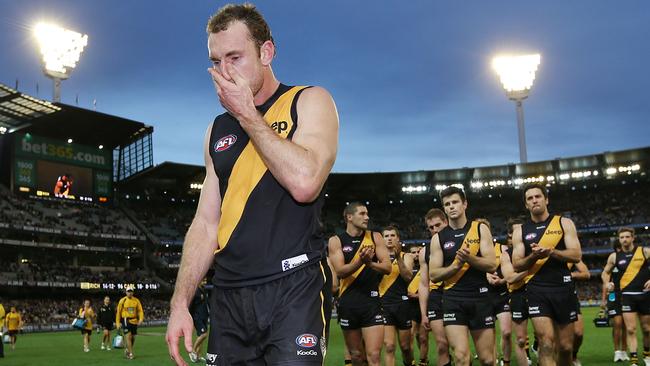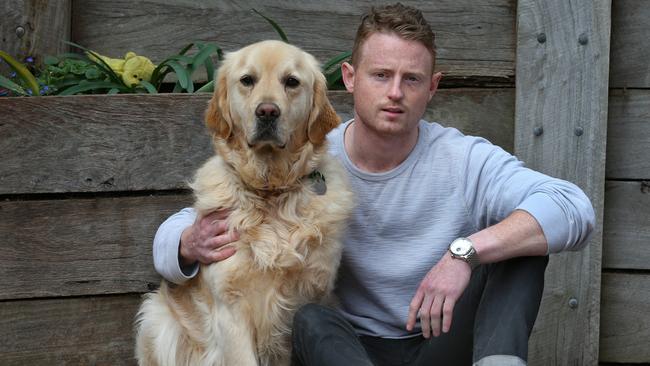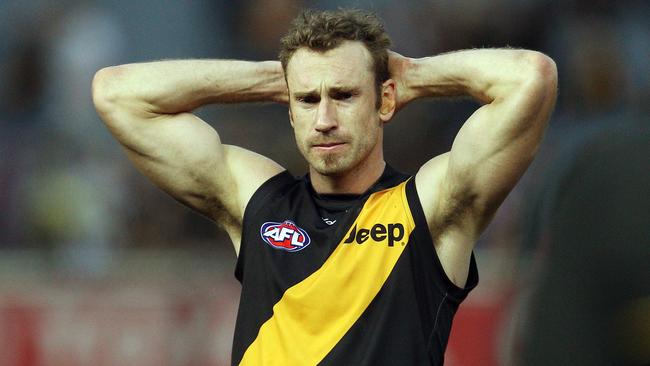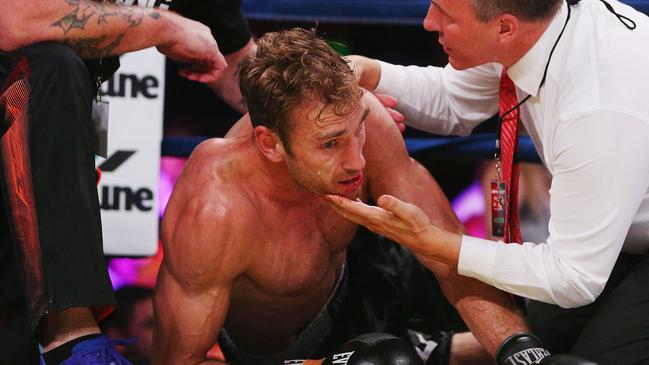Brain study shows former Tiger Shane Tuck had severe CTE
The fact Shane Tuck wasn’t repeatedly KO’d on the footy field has alarm bells ringing about the serious long-term impact of apparently minor hits.
AFL News
Don't miss out on the headlines from AFL News. Followed categories will be added to My News.
The diagnosis of the late Shane Tuck with CTE shows the “real challenge” of head knocks in the AFL and world sport, one of Australia’s top sports medicos says.
Tuck has become the third AFL player to be diagnosed with the crippling neurological disease inked to repeated head knocks — chronic traumatic encephalopathy — following the diagnosis of Graham “Polly” Farmer and Danny Frawley.
Ex-Richmond star Tuck died in July aged 38 and after his death his family donated his brain to the Australian Sports Brain Bank. The Brain Bank found that Tuck had the worst case of CTE it had seen.
Tuck did not have a playing history of major concussions, and Dr Peter Larkins told the Herald Sun this latest case highlighted the worrying fact that CTE can be caused even when players aren’t repeatedly knocked out.
“This is where the concept of subconcussion comes in,” Dr Larkins said.
“A subconcussion is a concussion that isn’t apparent to the fans at home and may not be obvious to the medical staff, where a guy gets a heavy bump and his head shakes.
“He doesn’t stagger, he doesn’t come off the ground. So what the medical research is saying that if you get a lot of these subconcussions you can develop CTE and that means you can’t even bump somebody in footy.
“So there is a real challenge to do something when we think you don’t even need to be fully concussed.”

Dr Larkins said the AFL, which he said was “conscious of head protection”, should expect more confirmed CTE cases to emerge.
“I think our awareness of the risk of CTE is has been growing over the past few years, so on one hand it is not surprising that these cases are emerging given the medical evidence that there seems to be a group of players who are prone to doing this,” he said.
“We have had Danny Frawley and Polly Farmer prior to this and I think we are going to have more unfortunately because clearly this is going to be a part of the research world sport is doing, not just the AFL.
“It is a huge concern, along with mental health it is probably the biggest challenging facing world sport and the AFL and any other sport where head injury occurs.”
Dr Larkins said the AFL had been proactive in rule changes to protect players with their head over the ball, but it may have to consider boosting funding for research into CTE.
“Funding for research is key, as it is in the medical world generally, so I think the AFL may need to increase its funding and it is also needs external funding – it is not just up to the AFL to do this,” he said.
“But how do we stop blokes running into each other, how are we going to stop blokes from taking high marks and landing awkwardly?
“We have already gotten rid of the sling tackle, we’ve taken out the behind-the-play hit, we have taken out the head over the ball front-on (contact).”
PLEA FOR MORE BRAIN DONORS
- Matt Turner
More former footballers need to seriously consider donating their brains for research after Shane Tuck became the third AFL player to have suffered from a crippling neurological disease linked to repeated head knocks.
That is the view of Australian Sports Brain Bank director Dr Michael Buckland and the organisation’s Victorian manager, Professor Alan Pearce, who also believe clubs must consider reducing contact training to minimise the risk of CTE – chronic traumatic encephalopathy.
The Brain Bank found ex-Richmond star Tuck, who died in July, aged 38, to have had the worst case of the degenerative disorder it had seen – severe stage three, nearly stage four.
CTE can only be diagnosed from analysing the brain after death.
Four AFL players’ brains have been analysed by the Bank and Tuck, a 173-game Tiger and the son of Hawthorn legend Michael Tuck, is the third with CTE.
Geelong legend Graham “Polly” Farmer, who died in 2019, was confirmed to have stage three of the disease last February, while St Kilda great, the late Danny Frawley, was found to have had stage two.
Pearce said more footballers donating their brains would help determine the rate of CTE.
“We ask former players to seriously consider pledging their brains to the Australian Sports Brain Bank and also we need financial donations to support the research at brainbank.org.au,” Pearce said.
“We’re not suggesting every footballer will get it, but we also don’t want to suggest that only these three brains will have it.
“We need to know what the rates are … and we can’t determine that off four brains.
“In America they’ve got thousands of brains that they’ve analysed and they’re the kind of numbers we need to have to be far more confident.”

Pearce and Buckland said the AFL had improved its concussion protocols in recent years and was ahead of some other sports in linking repeated head knocks and CTE.
But they said more steps should be taken to minimise the risk of the disease.
“We need to try to reduce contact in training because that’s what they do in America now with American football, but also modifying the sport at junior level,” said Pearce, also a concussion researcher at La Trobe University.
“Michael’s a neuropathologist, I’m a neuroscientist, we’re not going to tell sports how to change their games … but it’s something that we’d like these sports to think about.
“We don’t want to stop kids playing sport or change the DNA of our sports … but we need to reduce that risk.”
Buckland said all codes should have a separate policy on minimising the risk of CTE.
“Reducing total exposure over a lifetime should be the linchpin – that’s concussions and sub-concussive impacts,” he said.
“By limiting contact during training you could potentially make a significant reduction in that overall exposure.”
Pearce said the AFL could also improve its return-to-play policy because it was based around subjective medical judgment.
As it stands, players cannot be considered for selection unless they pass a concussion test five days before a game.
“Players have come out in the last couple of years saying they’ve tried to underplay their symptoms and sandbag the SCAT test, so we need to improve it with objective testing measures, further to the doctor’s decision-making, to give the doctor more confidence,” he said.
“Things like a blood test or what I do with brain stimulation, I can look at the brain’s function.”

Tuck’s family agreed for the Brain Bank to analyse the ex-Tiger in Sydney for concussion research as they tried to find answers to his mental health struggles.
People diagnosed with CTE tend to suffer from memory problems, cognitive functions and mood swings, while many develop depression and anxiety.
The Bank has had 17 brains analysed since launching in 2018.
Buckland called Tuck’s case of CTE “quite a shock because he’s quite young”.
The disease can be identified by a protein called tau, which builds up in the brain.
“In a 38-year-old, you shouldn’t see any tau in the frontal cortex,” Buckland said.
“As soon as I got the microscope slides, I didn’t need a microscope to see it.”
Tuck also had a short stint in boxing after his AFL career, which could have contributed to his CTE.
Former Melbourne and Geelong player Sam Blease has agreed to donate his brain for study.
“If we can help from a point of view in delaying or giving people a better understanding of what concussion looks like and the side effects and after affects not only in the short term and the long term, I know I’m more than happy to help out,” he said.
The 29-year-old, who last year said he had eight to 10 concussions over the course of his 34 senior games, said Australian sport was just uncovering the extent of CTE.
“I knew Shane from playing against him and he was a terrific footballer and person as well, obviously a very sad set of circumstances,” he said.
“And as we’ve seen in America you don’t know the extent of it until you cut the brain open and see what is there as we’ve seen with Shane Tuck, Polly Farmer and Danny Frawley.
“So it has come a long way from when I first started playing footy, but there is still some work that needs to be done.”

An AFL spokesperson said the league was thankful for the Tuck family helping with the important research.
They said the league took the health of past, present and future players very seriously and the AFL was interviewing for a position that would specifically focus on its work in response to concussion.
“Over recent years we have strengthened match-day protocols for the identification and management of concussion, we continue to change the laws of the game to discourage high contact and are using the ARC (review system) to provide another opportunity to identify potential concussive incidents … but we are committed to continually reviewing our response,” the spokesperson said.
The AFL is set to release its concussion guidelines “shortly”.
A coronial inquiry is ongoing.
- with Simeon Thomas-Wilson
STUDY SHOWS TUCK HAD SEVERE CTE
- Danny Russell, Michael Warner
The late Shane Tuck has become the third AFL player to have been found to have suffered from a crippling neurological disorder linked to repeated head knocks at the time of their death.
An analysis of the former Richmond star’s brain showed he had severe stage 3, borderline stage 4 CTE – chronic traumatic encephalopathy – when he died last July aged 38.
CTE can only be diagnosed after death.
The Australian Sports Brain Bank confirmed the finding, saying it was the “worst case” they had “seen so far”.
“It was actually quite shocking, the degree of disease he had,” neuropathologist professor Michael Buckland told Nine media.

Tuck, the son of Hawthorn legend Michael and who played 173 games for the Tigers, is the third VFL/AFL player to be diagnosed with CTE, the devastating condition linked to concussions and subconcussive hits.
Geelong legend Graham “Polly” Farmer, who died in August 2019, was confirmed to have Stage III CTE in February.
St Kilda great Danny Frawley, who died when his four-wheel drive struck a tree in Millbrook, near Ballan, on September 9 last year, was also found to have suffered from the condition.
Tuck’s family had agreed for his brain to be analysed by the Australian Brain Bank in Sydney for concussion research as they tried to find answers to his mental health struggles.
“Maybe post football, like a lot of sportspeople, trying to find their worth may have contributed to Shane’s struggles,” his brother Travis told the Herald Sun last year.
“And Shane getting involved with boxing, there might be a few concussions over time with football and boxing.

“Mum and dad took the option of doing that, and we’re very proud of them for doing that.”
Australian Sports Brain Bank state manager Professor Alan Pearce, a concussion researcher at La Trobe University, said Tuck was diagnosed with severe stage 3, borderline stage 4 CTE.
“While we know from international research that brain injury can increase risk of mental health issues, we need to engage in specific Australian research on exposure to brain trauma and risk of suicide,” Prof Pearce said.
“The unfortunate case now shows that CTE is a real disease and we need to put in place mechanisms to reduce exposure in contact sports like Australian rules and Rugby.
“We ask former players to seriously consider pledging their brains to the Australian Sports Brain Bank and also we need financial donations to support the research at brainbank.org.au”
An AFL spokesperson said the league was thankful for the Tuck family helping with the important research.
“We thank the Tuck family for their support of ongoing research in this area and for the ability to continue to learn about this condition and the AFL will, as previously, assist in that endeavour,” the spokesperson said.
“We take very seriously the health and safety of all present, past and future players in our game and are currently interviewing for a position at the AFL that will specifically focus on the work we are doing as an industry to respond to the issue of concussion.
“Over recent years we have strengthened match-day protocols for the identification and management of concussion, we continue to change the Laws of the Game to discourage high contact and are using the ARC to provide another opportunity to identify potential concussive incidents through the use of world leading video technology but we are committed to continually reviewing our response. The AFL’s Concussion Guidelines for the 2021 AFL and AFLW seasons will be released shortly.”
Originally published as Brain study shows former Tiger Shane Tuck had severe CTE
Read related topics:Concussion



